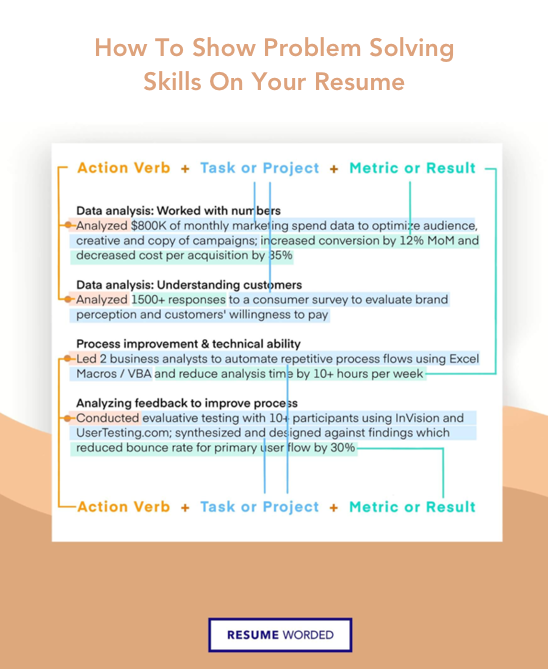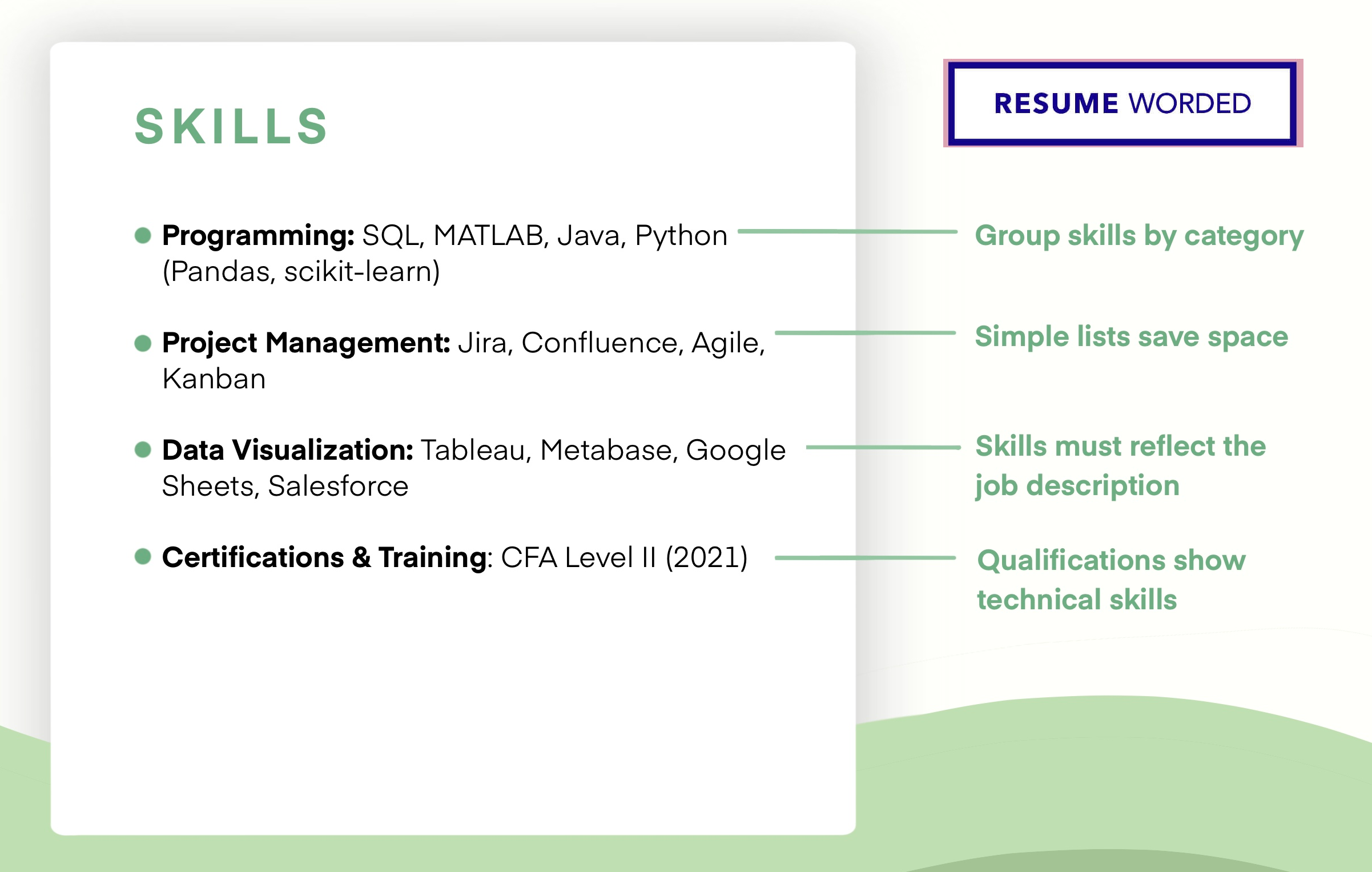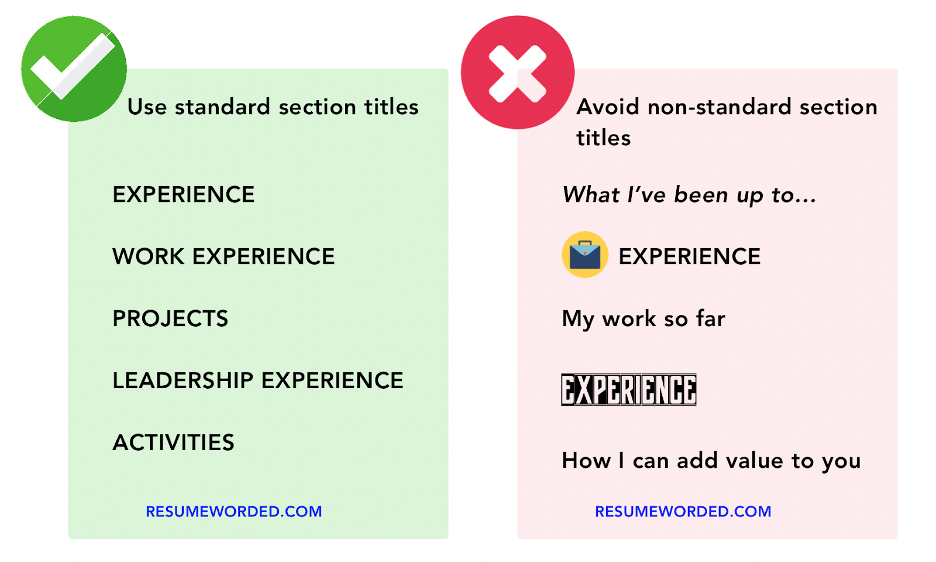Problem solving is a key skill in life — and in most workplaces. Like any other soft skill, it belongs on your resume. The only question is, how do you prove it?
Keep scrolling as we explain how to put problem solving on your resume in a way that actually lands. We'll also explain where soft skills like problem solving belong and give examples you can follow. But first, let's take a look at exactly what hiring managers mean when they say "problem solving."
Problem solving skills employers are looking for
If a job ad says that a company is looking for applicants with "strong problem solving skills," what does that actually mean?
Hiring managers want people with skills like:
- Critical thinking
- Research
- Analysis
- Creativity
- Brainstorming
- Troubleshooting
- Negotiation
- Conflict resolution
- Planning
- Organization
- Leadership
- Teamwork
- Communication
- Attention to detail
- Designing
- Experimenting
- Observation
That's a lot! So, how do you fit all that on your resume? Here are some tips to get you started.
How to show problem solving skills on a resume
To effectively showcase problem solving skills on your resume, follow these steps:
- Look at the job ad. What kinds of problem solving skills are specifically mentioned? What key responsibilities are likely to involve problem solving?
- Make a list of these skills or responsibilities — this is what you’ll want to address in your resume.
- Think of a time when you’ve demonstrated each problem solving skill or been in a similar situation.
- Format that incident as an accomplishment by starting with a strong action verb.
- Be specific about what you did and what the end result was.
- Check in with a free resume scanner to see how your accomplishments score and what you can improve.
Now let's take a look at where problem solving skills belong on your resume.
Where to include problem solving skills on a resume
The first thing to know is this: Problem solving is a soft skill, which means you should never list it directly in your skills section. Instead, you should:
- Include past examples of problem solving in your work experience bullet points
- List related hard skills in your skills section
- Mention key skills and accomplishments in your resume summary and cover letter
- Use synonyms to avoid repeating "problem solving" over and over
Emphasize real accomplishments
The best place for any soft skill — including problem solving — is in your Work Experience section. Make your bullet points stand out by outlining what the problem was, what action you took, and what the end result was.
Remember: The key is to be specific. For example, instead of:
Solved problems causing long delivery times.
Try:
Streamlined the implementation process and reduced the average product delivery time from 10 days to 4 days by redefining responsibilities and improving accountability of employees.
This specifies what the initial problem was, what action you took, and the end result. Use the formula [Action Verb] + [Accomplishment] + [Metric] to keep you on the right track.
List related hard skills
Problem solving is a soft skill, which means you can’t include it outright in your skills section. But what you can do is list hard skills that go hand in hand with problem solving.
For example:
- Data analysis
- Quality assurance
- Auditing
- Engineering
- Logistics
- Programming languages
- Loss prevention
- Accessibility
If you’re unsure what problem solving skills to include in your skills section, use the tool below to search for the job you’re applying to and it’ll give you a list of hard skills relevant to the job.
Include targeted highlights
If you’re applying for a role where you know that problem solving is an essential skill — like most management, data-driven, or customer-facing positions — you can emphasize your ability to solve problems in your resume summary or cover letter.
Do some research to identify the key issues facing the company, like streamlining inefficient business practices or expanding a small customer base, and highlight 2-3 skills or accomplishments related to those areas.
Here's an example:
Find out if your resume shows enough problem solving skills
An important thing to remember when listing problem solving skills on your resume is, just like other soft skills, you need to show how you’ve used problem solving skills in the past. An easy way to check if you’ve shown hiring managers your problem solving skills, is to upload your resume to the tool below — it’ll tell you if your resume has shown problem solving skills the right way, as well as other soft skills like leadership and communication skills.
Synonyms for problem solving on a resume
Trying to avoid repetition? If you’re searching for another word for problem solving to use on a resume, these action verbs have you covered:
- Redesigned
- Reduced
- Transformed
- Eliminated
- Improved
- Overhauled
- Revitalized
- Upgraded
- Developed
- Resolved
- Streamlined
- Identified
- Uncovered
- Mediated
- Analyzed
For even more suggestions, check out our list of resume action verbs for 2024.
Resume examples of problem solving skills
Looking for more ways to say that you’re a problem solver on a resume? Try these sample bullet points.
Proposed a plan to reduce shrink, which increased work efficiency and customer services by over 75%.
The first step in solving a problem is identifying it. Companies want to hire people who are proactive, not reactive, which means it's worth including an example of a time you first identified a problem and then took steps to solve it.
Developed a contingency plan during tough economic conditions to save $540K per year.
What's better than solving a problem? Preventing it from becoming a problem in the first place!
Reduced double-booking and error rates by 45%, resulting in a $10,800 increase in yearly sales by developing a scheduling system to coordinate advertising space availability with Sales, Designers, and the Editorial team.
The more specific you can get with your bullet points, the better. Remember, the main point of your resume isn't just to show a recruiter what you've done for other companies — it's to help them imagine what you might do for their company.
Executed self-insured health plan including wellness benefits which saved the business in excess of $70K or 20% and influenced over 200 staff members to become healthier.
What hiring managers want to see is results. Any time you can identify a specific positive outcome in your bullet points, you take one step closer to getting hired.
Responded to and managed 50+ inbound requests from members daily.
Struggling to quantify your achievements? It's okay if you don't have access to specific metrics — you can still include numbers for things like how many projects you worked on or how quickly you completed tasks.










